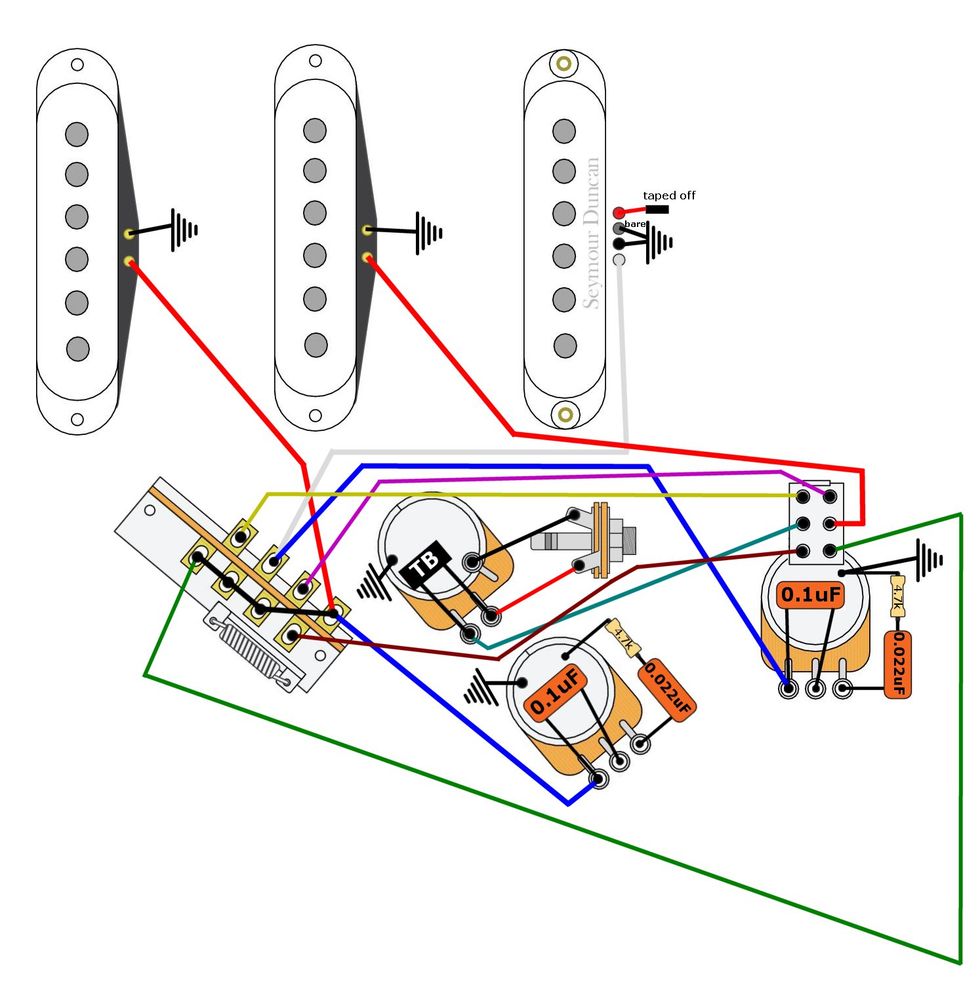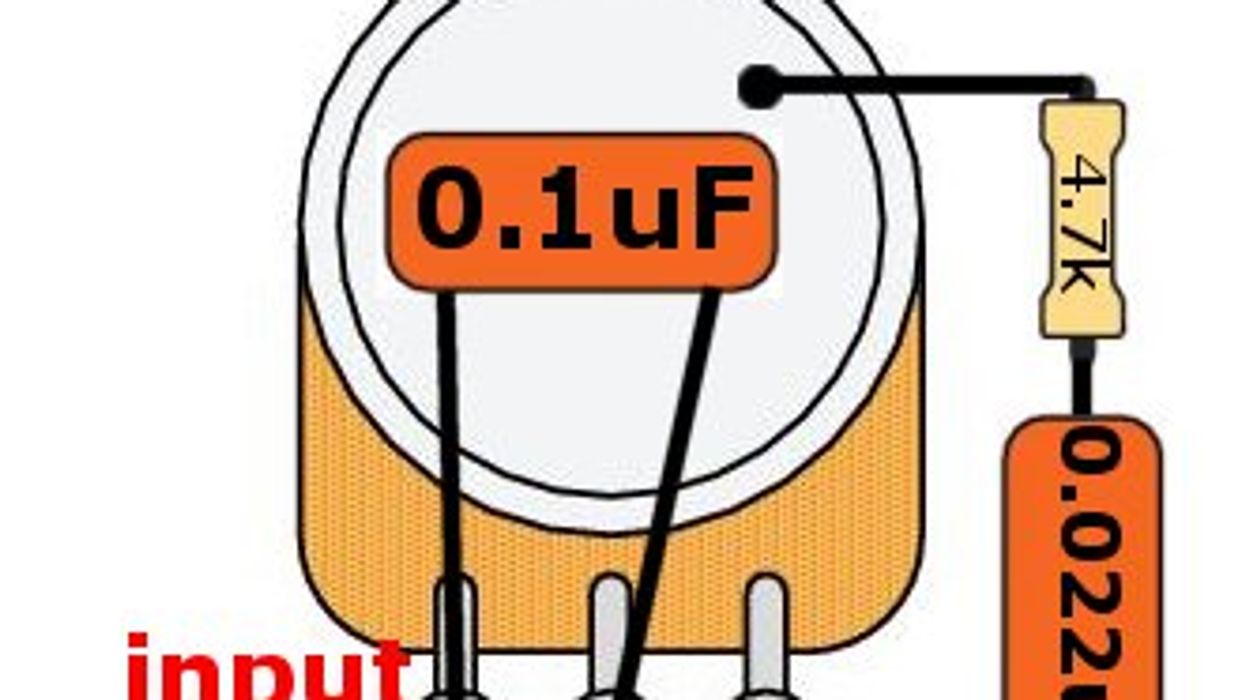Hello and welcome back to Mod Garage. In this edition, we’re continuing our journey through the Fender Cory Wong Stratocaster wiring, bringing it all together.In the previous installment, the last feature on the funky 6-stringer’s signature axe that we discussed was the master volume pot and the corresponding treble-bleed circuit. Now, let’s continue with this guitar’s very special configuration of the tone pots.
Tone pot with Fender Greasebucket tone system:
This 250k tone pot is a standard CTS pot with a 90/10 audio taper found in all U.S.-built Fender guitars. The Cory Wong guitar uses the Fender Greasebucket system, which is added to the pot as a ready-to-solder PCB. The Greasebucket PCB is also available individually from Fender (part #7713546000), though you can use conventional electronic parts for this.
Fender introduced this feature in 2005 on some of the Highway One models and some assorted Custom Shop Strats. The Greasebucket name (which is a registered Fender trademark, by the way) is my favorite of Fender’s marketing names, but don’t let it fool you: Your tone will get cleaner with this modification, not greasy and dirty.
According to Fender, the Greasebucket tone circuit reduces high frequencies without adding bass as the tone knob is turned down. Don’t let that description confuse you. A standard Strat tone control does not add any bass frequencies! As you already know, with a passive system you can’t add anything that isn’t already there. You can reshape the tone by deemphasizing certain frequencies and making others more prominent. Removing highs makes lows more apparent and vice versa. In addition, the use of inductors (which is how a passive pickup behaves in a guitar circuit) and capacitors can create resonant peaks and valleys (band-passes and notches), further coloring the overall tone.

Cory Wong bringing the funk onstage.
This type of band-pass filter only allows certain frequencies to pass through, while others are blocked. The standard tone circuit in a Strat is called a variable low-pass filter (or a treble-cut filter), which only allows the low frequencies to pass through while the high frequencies get sent to ground via the tone cap.
The Greasebucket’s band-pass filter is a combination of a high-pass and a low-pass filter. This is supposed to cut high frequencies without “adding” bass, which has mostly to do with the resistor in series with the pot. That resistor means the control will never get to zero. You can get a similar effect by simply not turning the Strat’s standard tone control all the way down. (The additional cap on the wiper of the Greasebucket circuit complicates things a bit, though; together with the pickups it forms an RLC circuit, but I really don’t want to get into that here.)
The standard Fender Greasebucket tone system is used in the Cory Wong Strat, which includes a 0.1 μF cap and a 0.022 uF cap, along with a 4.7k-ohm resistor in series. These are the values used on the PCB, and without the PCB it looks like the illustration at the top of this column.
Push-push tone pot with preset overwriting function:
The lower tone pot assigned to the bridge pickup is a 250k audio push-push pot with a DPDT switch. The switch is used to engage a preset sound by overwriting the 5-way pickup-selector switch, no matter what switching position it is in. The preset functionality has a very long tradition in the house of Fender, dating back to the early ’50s, when Leo Fender designed a preset bass sound on position 3 (where the typical neck position is on a modern guitar) of the Broadcaster (and later the Telecaster) circuit. Wong loves the middle-and-neck-in-parallel pickup combination, so that’s the preset sound his push-push tone pot is wired for.
The neck pickup has a dedicated tone control while the middle pickup doesn’t, which is also another interesting feature. This means that when you hit the push-push switch, you will engage the neck and middle pickup together in parallel, no matter what you have dialed in on the 5-way switch. Hit the push-push switch again, and the 5-way switch is back to its normal functionality. Instead of a push-push pot, you can naturally use a push-pull pot or a DPDT toggle switch in combination with a normal 250k audio pot.
Here we go for the wiring. For a much clearer visualization, I used the international symbol for ground wherever possible instead of drawing another black wire, because we already have a ton of crossing wires in this drawing. I also simplified the treble-bleed circuit to keep things clearer; you’ll find the architecture of it with the correct values in the previous column.

Cory Wong Strat wiring
Courtesy of singlecoil.com
Wow, this really is a personalized signature guitar down to the bone, and Wong used his opportunity to create a unique instrument. Often, signature instruments deliver custom colors or very small aesthetic or functional details, so the Cory Wong Stratocaster really stands out.
That’s it! In our next column, we will continue our Stratocaster journey in the 70th year of this guitar by having a look at the famous Rory Gallagher Stratocaster, so stay tuned!
Until then ... keep on modding!






































